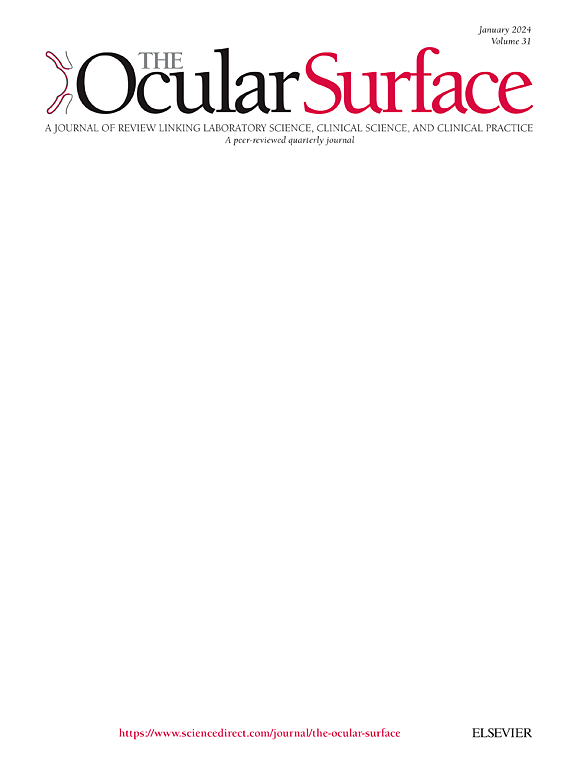Janus kinase inhibitors in the treatment of refractory cicatrizing conjunctivitis in pemphigoid
IF 5.6
1区 医学
Q1 OPHTHALMOLOGY
引用次数: 0
Abstract
Objective
To evaluate the efficacy of Janus kinase inhibitor (JAKi) therapy in managing cicatrizing conjunctivitis associated with ocular cicatricial pemphigoid (OCP) and mucous membrane pemphigoid with ocular involvement (ocMMP).
Methods
Retrospective chart review of patients with cicatrizing conjunctivitis secondary to OCP or ocMMP who underwent treatment with JAKi at a tertiary academic medical center from August 2015 to November 2024 for minimum follow-up of six months. Collected data included demographics, Foster stage of cicatrization, and treatment course.
Results
Thirty-two patients met inclusion criteria: 23 (71.9 %) with OCP and 9 (28.1 %) with ocMMP. 96.9 % of patients demonstrated clinical improvement within twelve months of treatment initiation. Best response achieved were as follows: 1 (3.1 %) no response, 17 (53.1 %) partial response, 14 (43.8 %) complete remission, and 12 (37.5 %) steroid-free complete remission. The mean time to partial response, complete remission, steroid-free complete remission was 3.1 ± 1.8 (range, 0.9–8.3), 7.8 ± 3.3 months (range, 2.3–14.7 months), and 10.3 ± 7.4 months, (range, 2.3–31.4 months), respectively. Relapse in disease activity occurred in 8/32 (25.0 %) of patients. Side effects occurred in 8/32 (25.0 %) of patients. Four patients (12.5 %) discontinued therapy due to severe adverse events, including transient ischemic attack, pulmonary embolism, pyelonephritis, and cholecystitis. There was a significant association between lower Foster cicatrization stages and achieving remission (U = 630.0, p = 0.0036), with a rank-biserial correlation of 0.72.
Conclusions
JAK inhibitor therapy demonstrates efficacy in the management of recalcitrant cicatrizing conjunctivitis associated with pemphigoid. These findings highlight JAK inhibitors as a promising therapeutic option for refractory cases.
Janus激酶抑制剂治疗类天疱疮难治性结膜炎。
目的:评价Janus激酶抑制剂(JAKinib)治疗瘢痕性结膜炎伴眼瘢痕性类天疱疮(OCP)和黏膜类天疱疮伴眼累及(ocMMP)的疗效。方法:回顾性分析2015年8月至2024年11月在某三级学术医疗中心接受JAKinibs治疗的OCP或ocMMP继发瘢痕性结膜炎患者,随访时间至少为6个月。收集的数据包括人口统计学、愈合培养阶段和疗程。结果:32例患者符合纳入标准:OCP 23例(71.9%),ocMMP 9例(28.1%)。96.9%的患者在开始治疗的12个月内表现出临床改善。获得的最佳缓解如下:1例(3.1%)无缓解,17例(53.1%)部分缓解,14例(43.8%)完全临床缓解,12例(37.5%)无类固醇缓解。达到部分缓解、完全临床缓解和无类固醇缓解的平均时间分别为3.1±1.8个月(范围0.9-8.3)、7.8±3.3个月(范围2.3-14.7个月)和10.3±7.4个月(范围2.3-31.4个月)。8/32(25.0%)患者出现疾病活动复发。32例患者中有8例(25.0%)出现不良反应。4例患者(12.5%)因严重不良事件停止治疗,包括短暂性脑缺血发作、肺栓塞、肾盂肾炎和胆囊炎。较低的福斯特愈合阶段与获得缓解之间存在显著相关(U = 630.0, p = 0.0036),秩双列相关系数为0.72。结论:JAK抑制剂治疗与类天疱疮相关的顽固性结膜炎有效。这些发现突出了JAK抑制剂作为难治性病例的一种有希望的治疗选择。
本文章由计算机程序翻译,如有差异,请以英文原文为准。
求助全文
约1分钟内获得全文
求助全文
来源期刊

Ocular Surface
医学-眼科学
CiteScore
11.60
自引率
14.10%
发文量
97
审稿时长
39 days
期刊介绍:
The Ocular Surface, a quarterly, a peer-reviewed journal, is an authoritative resource that integrates and interprets major findings in diverse fields related to the ocular surface, including ophthalmology, optometry, genetics, molecular biology, pharmacology, immunology, infectious disease, and epidemiology. Its critical review articles cover the most current knowledge on medical and surgical management of ocular surface pathology, new understandings of ocular surface physiology, the meaning of recent discoveries on how the ocular surface responds to injury and disease, and updates on drug and device development. The journal also publishes select original research reports and articles describing cutting-edge techniques and technology in the field.
Benefits to authors
We also provide many author benefits, such as free PDFs, a liberal copyright policy, special discounts on Elsevier publications and much more. Please click here for more information on our author services.
Please see our Guide for Authors for information on article submission. If you require any further information or help, please visit our Support Center
 求助内容:
求助内容: 应助结果提醒方式:
应助结果提醒方式:


